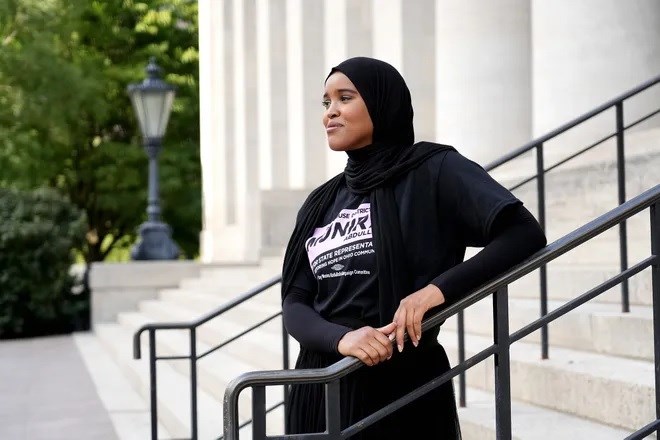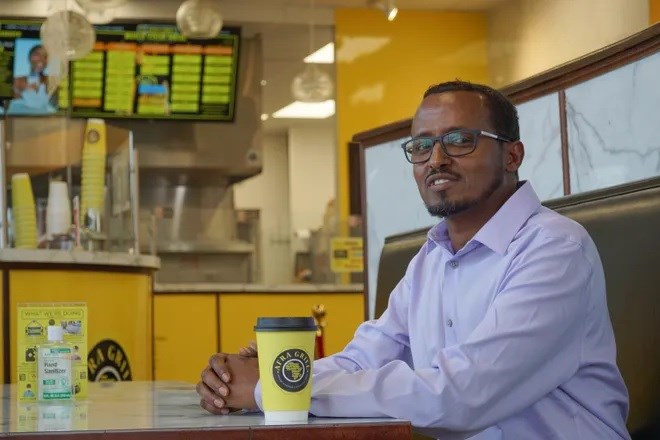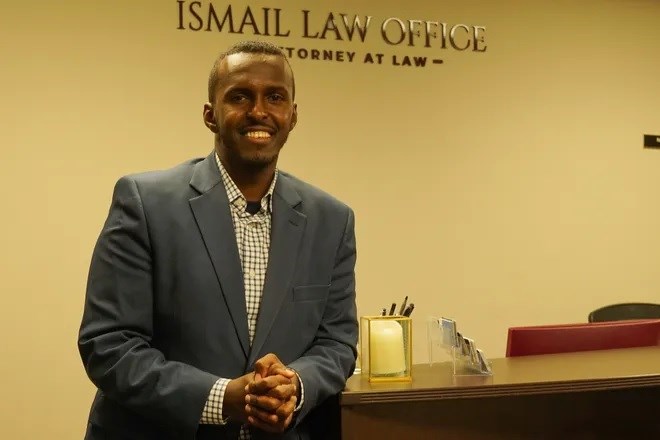
Monday August 15, 2022
By Peter Gill

Somali-American Munira Abdullahi won the Democratic primary for House District 9 at the Ohio Statehouse. She is almost guaranteed to win the general election in November since the Republican Party is not fielding a candidate. No Somali-American has served in Ohio's legislature. Fred Squillante/ Columbus Dispatch
For the first time in its history, Ohio is on the precipice of having a Somali American — maybe even two — serve in the state legislature.
It's an accomplishment that members of the new American community say has required overcoming a host of roadblocks: years of internal political apathy as well as external racism and Islamophobia, less-than-favorable municipal electoral systems, and hesitance from the state’s Democratic leadership.
Munira Abdullahi, 26, who was born in a refugee camp in Kenya, prevailed over those factors by winning the Democratic primary for Ohio House of Representatives’ District 9 in a landslide on Aug. 2. She campaigned on a progressive platform of Medicaid expansion, green energy and investing more in affordable housing.
Abdullahi’s success means she is almost guaranteed to win the general election in November; her district in Columbus leans so heavily Democratic that the Republican Party is not even fielding a candidate.
She said she does not take the responsibility lightly.
“I truly believe the legislature needs to reflect the community that it serves,” she said. “I think having someone who has been part of the community — who understands the struggles, understands the people in a personal capacity — will make a huge difference in having their concerns heard.”
Another Somali American candidate, Ismail Mohamed, 29, is neck-and-neck with another candidate in the Democratic primary for House District 3 in Columbus, another heavily Democratic district.
Not only would Abdullahi and Mohamed be the first Somali Americans in the state legislature, they also could be the first from the community in any publicly elected office in Ohio, according to local Somali Americans.
The city of Columbus, though it has the second-largest Somali-American community in the nation with around 60,000 residents, has never had a Somali as a member of the city council or Columbus City Schools Board of Education.
It is not as if Somalis from Columbus have not run for office before, though.
Before his campaign this year, Mohamed narrowly lost a Democratic primary race against incumbent state Rep. Bernadine Kennedy Kent in 2018. Mohamud Jama, an electrical engineer and businessman, ran for the same seat in 2020 and came in second to state Rep. Dontavius Jarrells. Another community member, Mohamed Ali, campaigned for Columbus City school board in 2021.
“We live here, we create jobs, we made the neighborhoods alive — especially the North Side of Columbus,” Jama said. “We created thriving businesses that employ people that live here in this district.”
But being Black, Muslim, and an immigrant makes it challenging to win elections, Jama said.

Mohamud Jama, 50, an electrical engineer and businessman, ran for House District 25 in 2020. Peter Gill/ Columbus Dispatch
“When someone comes in and sees on the ballot ‘Mohammed’ versus ‘John,’ my name is like a stranger to his brain. Unless he knows me personally, he wouldn’t vote for me.”
Minnesota leads the way
Minnesota, which has the largest Somali population in the U.S., has led the way in electing Somali Americans.
Minneapolis chose a Somali American for school board in 2010, followed by a city council member in 2013. Ilhan Omar won a Minnesota statehouse seat in 2016 and then joined the U.S. Congressional delegation in 2018 — making her the first Somali American in both of those bodies.
“Minnesota, in general, is more liberal, more welcoming, than the state of Ohio,” said Jibril Mohamed (no relation to Ismail), a Somali language professor at Ohio State University and director of the nonprofit SomaliCAN, which seeks to promote social, economic and political integration.
States and cities with smaller Somali populations than Columbus, like Oregon and SeaTac, Washington, also have elected Somali Americans. South Portland, Maine, elected Deqa Dhalac, a Somali woman, as mayor last year.
Jibril Mohamed pointed out that the Columbus Division of Police does not allow female officers to wear the hijab, the Muslim head covering worn by many Somali women, whereas police departments in Minneapolis and many other major cities do so.
Minneapolis' electoral system may also explain why it elected Somali representatives sooner.
The city's voters elect 13 city council members to represent the ward in which they live. By contrast, Columbus currently uses an at-large system, whereby all voters cast ballots for all seven seats on the council.
“It’s really hard for minority candidates in majority white cities to get elected in at-large elections,” explained Stefanie Chambers, a political science professor at Trinity College in Connecticut who wrote a book comparing the Somali communities of Columbus and Minneapolis.
Former Columbus Mayor Michael B. Coleman, who served from 2000 until 2016, is Black, and four of the current city council members are people of color. But many Somalis feel that the at-large system has shut them out.
If Columbus used a ward-based system for city council and school board elections, Somali Americans could form a voting block in neighborhoods where they are most concentrated. More representatives at the city level could lead to more at the state level as well, since politicians often cut their teeth in city government before running for state office.
Political success also simply takes time, according to Ibrahim Hirsi, a history PhD candidate at the University of Minnesota who studies early Somali emigration.
While Somalis began moving to Minnesota in the 1990s, the Somali community in central Ohio is newer, having established itself in the 2000s.
“In the '90s and early 2000s, and even mid-2000s, Somalis in Minnesota were kind of in survival mode, getting jobs and trying to establish a community. It wasn’t until later that they began running for office,” Hirsi said.
Young candidates from Columbus
Both candidates Abdullahi and Ismail Mohamed belong to a younger generation of Somalis who came of age in the U.S. and graduated from college here.
Abdullahi, a program manager for the nonprofit Muslim American Society, was a political science major at Ohio State. Ismail Mohamed has a law degree from OSU’s Moritz College of Law and practices personal injury, immigration and housing law out of his own office on Columbus’ North Side.
Jibril Mohamed, the Ohio State professor, said education has been crucial historically to political participation.
“Now, young people are graduating from universities and colleges, and have become capable of conducting their own assessments of their political opportunities,” he said.
Abdullahi received endorsements this year from several state Democratic leaders, including Allison Russo, Ohio House minority leader. She said the endorsements made a difference, especially among non-Somali voters.

Ismail Mohamed, 29, is neck-an-neck with another candidate in the Democratic primary for House District 3. Peter Hill/Columbus Dispatch
However, Ohio Democratic leaders were not always receptive to Somali constituents, according to members of the local community.
Jama said that when he began working on other city Democrats’ campaigns in the late 2000s, he had a hard time convincing non-Somali candidates to reach out to his community.
“Republicans and Democrats saw us as foreigners — people that came from a different country, with a Muslim background,” he said. “But now, our votes are valued. It’s to a point where whoever wants to run for a seat in Franklin County, they come to us, they want talk to the Somali community.”
A unique primary
Abdullahi’s win and Mohamed’s still-to-be-decided race may have been influenced by the unique circumstances of the recent primary.
Because Ohio already held a primary for governor and federal races in May, voter turnout in this month’s statehouse primary was very low, with just 7% of voters casting ballots in Franklin County. In the Somali community, that low turnout could have boosted the impact of Abdullahi’s and Mohamed’s dedicated supporters.
Still, that doesn't mean that Somalis’ entrance into Ohio politics is a fluke. Professor Jibril Mohamed is optimistic that Columbus’ transition to a district-based electoral system — a hybrid between the at-large and ward-based systems that will be implemented in 2023 — will open doors to more Somali candidates at the city level.
Meanwhile, candidate Ismail Mohamed said he awaits the final election results with bated breath. As of Thursday, he leads his opponent, Kelly Harrop, by 37 votes, but there were 150 provisional ballots and 145 absentee ballots not yet returned.
“It’d be great if it could be both of us — Munira and me,” he said. “All it takes is that one person to win, that one person to make history, and then folks get a lot more excited."